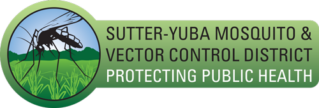Mosquito-borne encephalitis/encephalomyelitis are viral diseases that are transmitted to humans and animals by mosquitoes. Encephalitis refers to an inflammation of the brain, and encephalomyelitis refers to an inflammation of the brain and spinal cord. In California, West Nile Virus (WNV), Western Equine encephalitis (WEE), and St. Louis encephalitis (SLE) are the three most important viruses that can cause mosquito-borne encephalitis/encephalomyelitis. These viruses are maintained in nature through a bird – mosquito – bird cycle. Birds that are common in California such as the American crow, English house sparrow and the house finch are important hosts or reservoirs of these viruses.
The mosquitoes that transmit WEE and SLE prefer to bite birds, but sometimes these encephalitis viruses are accidentally passed to humans when mosquitoes bite them instead of birds. Theses viruses cannot be transmitted from person to person. Humans are not carriers, hosts or reservoirs for these diseases. Occasionally, breast fed infants, unborn fetuses and blood and organ donor recipients can contract these viruses, but the incidence of this happening is very low. Horses are also susceptible to infection with WNV and WEE, and in many cases they die or must be euthanized. St. Louis encephalitis does not cause disease in horses. Vaccines to protect horses from WNV and WEE are in use, but unfortunately none are available for humans. In addition, there are no vaccines to protect humans from SLE. For more information on WNV, please refer to the section on WNV on this website. Additional information on WNV is available at www.westnile.ca.gov

Western Equine encephalitis and St. Louis encephalitis appear to be endemic (always present) in many regions of California. Major epidemics of both viruses have occurred in California in the past, but very few human cases have been reported in recent times. Currently, WEE and SLE have been found mostly in the southern part of the state. The last time WEE was found in the Sutter-Yuba area was in samples of mosquitoes collected and tested in 1997. SLE, until 2017, had not been found in the Sutter-Yuba area since the 1960’s, according to a recent records search. SLE has been found in Southern and Central California in 2015 and 2016. The most recent SLE positive mosquitoes were found in the Plumas Lake area of Yuba County in August of 2017. Western Equine encephalitis is found sporadically, again mostly in southern California, and is also found in the western and central United States, Canada, and parts of Central America. St. Louis encephalitis is found in most of the United States and in Canada, Trinidad, Jamaica, Panama and Brazil.
In the Sutter-Yuba area, Culex tarsalis and Culex pipiens are the main vectors of these diseases. Both species are very common in our area, with Culex tarsalis being the most numerous. Sources for Culex tarsalis include wetlands, duck clubs, rice fields, pastures and abandoned/unmaintained swimming pools, just to list a few. Culex pipiens are more urban in nature, and can be found in catch basins, drainage ditches, abandoned/unmaintained swimming pools and containers in yards and property that can hold water such as buckets, pet dishes, water troughs, ornamental ponds and small swimming pools for children. Mosquito control practices and community action in cleaning up yards and maintaining urban water features can help reduce numbers of these mosquitoes.
Symptoms of these arboviruses generally develop within 5 to 15 days after being bitten by an infected mosquito. Initial symptoms are often flu-like lasting 5 to 10 days with fever, headache, nausea and vomiting. If the disease progresses, meningitis-like symptoms may occur. This is a serious form of the illness and victims should be under the care of a physician. Symptoms may be flu-like with a notably severe headache and stiff neck lasting 3 to 10 days. In about 1% of WEE infections encephalitis will develop. This condition can be very severe with inflammation of the brain and may require hospitalization, with a duration of about 14 to 21 days. Symptoms can include delirium, stupor, convulsions, coma and death. Western Equine encephalitis is more severe in infants, while SLE is most severe in the elderly. Many people infected with WEE or SLE will never have symptoms, and never know they had the disease.
Most cases of WEE or SLE (approximately 80%) occur during the summer months of July and August. Once infected, there is no specific medical treatment available other than professional supportive care. The best way to avoid any disease carried by mosquitoes is to reduce your exposure to mosquitoes and their bites. Drain all stagnant water on your property. Make use of mosquitofish in suitable mosquito sources such as ornamental ponds, watering troughs and any containers that hold water for more than 4 days. Mosquitofish can be picked up at our District yard for your use, free of charge. Make sure window and door screens are tight fitting and free of tears and holes. Wear long pants, long sleeved shirts and socks with shoes when outdoors. Apply an insect repellant, following all label directions. Reduce or eliminate outdoor activities at dawn and dusk, as these are the times that encephalitis carrying mosquitoes are most active.
For more information on these and other kinds of mosquito-borne encephalitis, the Centers for Disease Control and Prevention has information available on their website.
